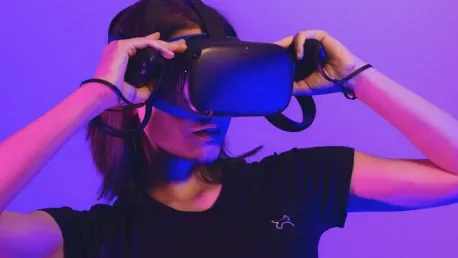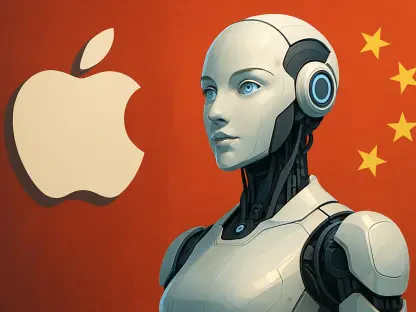The Global Augmented Reality (AR) and Virtual Reality (VR) display market is poised for extraordinary growth, with the market size expected to balloon from USD 2.7 billion in 2023 to approximately USD 26.4 billion by 2033, driven by technological advancements and increased adoption across various industries. This rapid expansion is underscored by a compound annual growth rate (CAGR) of 25.6%, highlighting the substantial market potential in the coming decade.
Regional Dominance of the Asia Pacific
In 2023, the Asia Pacific region accounted for 41.6% of the global market share, demonstrating its leadership in the AR and VR display sector. This dominance is largely due to the rapid technological advancements and significant investments made by countries such as China, Japan, and South Korea. These nations have been at the forefront of AR and VR innovation, driving the regional market forward with robust development efforts and financial backing.
Key Sectors Driving Growth
Gaming and entertainment continue to be major growth drivers for AR and VR technologies. These sectors benefit from the immersive experiences that AR and VR can offer, making them appealing to consumers who seek cutting-edge interactions. Additionally, the healthcare sector has started to leverage AR and VR for surgical simulations and training, significantly improving educational outcomes and operational efficiencies. Virtual classrooms using these technologies are also transforming education, offering interactive and engaging learning environments.
Market Dynamics and Statistics
The Global Virtual Reality Headset Market is projected to expand to USD 121.9 billion by 2032, with a promising CAGR of 29.1%. This growth is fueled by the headsets’ widespread application across gaming, healthcare, and training sectors. The Extended Reality (XR) Market is also anticipated to rise significantly, potentially reaching USD 519.5 billion by 2032, reflecting a CAGR of 30.8%. Such robust growth underscores the integration of XR into various enterprise and consumer applications. Similarly, the Global Mixed Reality Market, with its impressive projected CAGR of 43.2%, and the Global Immersive Reality Technologies Market, anticipated to grow at a CAGR of 24%, further illustrate the expansive opportunities driven by the surging demand for immersive experiences.
Emerging Trends and Technological Advancements
Recent trends indicate that technological advancements like generative AI, multi-sensory experiences, and WebAR (Web-based Augmented Reality) are enriching AR and VR environments. These innovations are creating more engaging and interactive digital experiences, making the technology more appealing and accessible. Moreover, user-friendly devices from leading companies like Apple and Meta enhance the usability of AR and VR, contributing to their broader adoption.
Top Use Cases Across Industries
The use cases for AR and VR are expanding across several industries. In e-commerce, AR is enhancing customer interactions through virtual try-ons and interactive showrooms. In the automotive industry, AR heads-up displays are elevating navigation and safety, with notable implementations by manufacturers like Mercedes-Benz and Audi. Additionally, remote assistance and training are becoming more effective with AR, while healthcare applications are benefiting from improved surgical precision and mental health treatments.
Challenges and Barriers
Despite the optimistic outlook, the AR and VR market faces several challenges, including high costs, limited understanding of ROI, technological limitations, complex content creation processes, and user experience concerns. Overcoming these barriers will be critical for the continued success and growth of AR and VR technologies, necessitating ongoing innovation and solution development.
Future Opportunities
The potential for AR and VR to enhance real-world interactions, provide immersive learning and training, and innovate marketing and advertising strategies is immense. Remote collaboration and virtual workspaces are also set to benefit significantly from these technologies, as are advancements in healthcare for surgical precision and mental health treatment. As AR and VR continue to integrate into various applications, their overall market growth is likely to accelerate further.
Conclusion
The Global Augmented Reality (AR) and Virtual Reality (VR) display market is on the brink of significant expansion. Currently valued at USD 2.7 billion in 2023, this market is projected to soar to nearly USD 26.4 billion by 2033. Such impressive growth can be attributed to ongoing technological innovations and the broadening application of AR and VR across various sectors, including gaming, healthcare, education, and retail. The adoption rates are spiking as these technologies prove valuable for immersive experiences, training simulations, and customer engagement. Furthermore, the market’s robust expansion is marked by a compound annual growth rate (CAGR) of 25.6%, emphasizing the tremendous potential over the next decade. Industries are increasingly integrating AR and VR into their operations to enhance user experience and streamline processes. This upward trajectory is not just a trend but a significant shift indicating how pivotal AR and VR technologies will be in shaping the future of digital interaction, making substantial impacts on both consumer markets and enterprise solutions.









